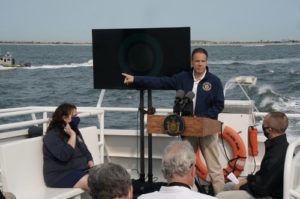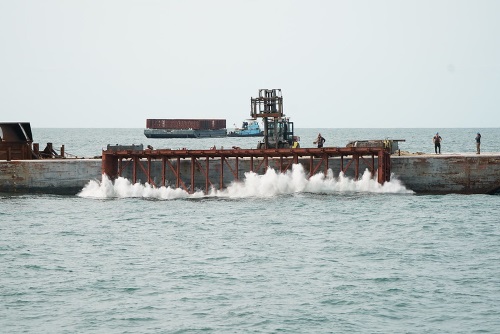The New York State Department of Transportation is helping expand a series of artificial reefs off the shores of Long Island as part of a three-year long multiagency effort. In September, the agency helped dump a retired tugboat, 16 rail cars, and a streel turbine on Hempstead Reef – the first of multiple “reef deployments” scheduled for 2020.
[Photo courtesy of New York State DOT.]

In his 2020 State of the State address, Governor Andrew Cuomo (D) committed to doubling New York’s existing reef acreage by expanding seven of 12 existing sites and creating four new artificial reefs in Long Island Sound and the Atlantic Ocean – an expansion expected to be complete by 2022.
“[We are] proud to work with our sister agencies on this important program, repurposing transportation materials to expand artificial reefs and support biodiversity, fishing, and tourism,” explained Marie Therese Dominguez, NYSDOT’s commissioner, in a statement.
“It is another example of how [our state] is taking bold steps to protect our ecosystems and foster sustainable economic growth that will benefit current and future generations of New Yorkers,” she said.
The New York State Department of Environmental Conservation or DEC manages the state’s 12 artificial reefs, which include two reefs in Long Island Sound, two in the Great South Bay, and eight in the Atlantic Ocean. The 413-acre Atlantic Beach Reef is located three nautical miles south of Atlantic Beach with a depth of 55 to 64 feet. One of the first reefs created in New York, this reef was previously comprised of two vessels, nine barges, surplus armored vehicles, 404 auto bodies, 10 Good Humor trucks, steel crane and boom, rock, concrete slabs, pipes, culvert, decking, and rubble.
Moving forward, recycled materials from NYSDOT, New York Power Authority/Canal Corporation, and the Thruway Authority – among other public and private partners – are being put to new use to develop New York’s artificial reef sites.
The types of materials deployed onto the reefs from the NYSDOT over the last year include old concrete highway barriers, steel girders with concrete tops from the Staten Island Expressway, and 15 steel pipes from the old Kosciuszko Bridge; replaced by a new structure that opened in 2019.

The DEC said those materials are then “strategically placed” to expand the reef, with the agency overseeing the cleaning of contaminants from recycled reef materials to mitigate potential impacts to sea life before being deployed to the reef sites. Once materials and vessels settle to the seafloor, larger fish – such as blackfish, black sea bass, cod, and summer flounder – move in to inhabit the new structures, and encrusting organisms such as barnacles, sponges, anemones, corals, and mussels cling to and cover the material. Over time, the recycled structures create a habitat mimicking that of a natural reef, DEC noted.

